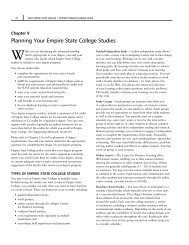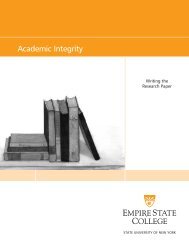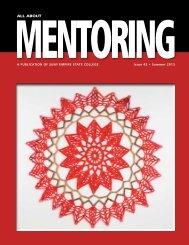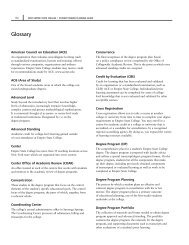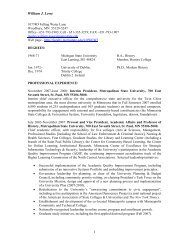All About Mentoring Spring 2011 - SUNY Empire State College
All About Mentoring Spring 2011 - SUNY Empire State College
All About Mentoring Spring 2011 - SUNY Empire State College
Create successful ePaper yourself
Turn your PDF publications into a flip-book with our unique Google optimized e-Paper software.
64<br />
turn fared better than the poor. Perhaps it<br />
was the PRI that fared worst of all. In many<br />
ways, its credibility never recovered.<br />
In September 1985, the PRI suffered<br />
another major blow following a massive<br />
earthquake that rocked the capital. Damage<br />
was widespread and a great many people<br />
died, yet the PRI, in the following days, was<br />
invisible. Local people seized the initiative<br />
and quickly mobilized to search for victims<br />
and provide services for survivors. When<br />
the PRI belatedly leapt into action,<br />
having initially minimized the damage<br />
and assured international experts that<br />
help was not needed, it sent in the army<br />
to protect private property. The party<br />
was further discredited when post-quake<br />
analysis suggested the pattern of building<br />
collapses revealed one of the many costs<br />
of corruption. Contractors working on<br />
government buildings, including hospitals<br />
and schools had clearly used shoddy<br />
materials and government inspectors had<br />
been paid off.<br />
that national leaders promised would pave<br />
the way for Mexico’s transformation into<br />
a fully developed country. What Mexicans<br />
refer to as the “intellectual authors” of<br />
the assassination was never identified.<br />
That fall, Jose Francisco Ruiz Massieu, an<br />
official of the PRI and a national senator,<br />
was assassinated. During the months that<br />
followed, investigations revealed what<br />
historians Michael C. Meyer, William L.<br />
Sherman and Susan M. Deeds (2007) refer<br />
to as follows:<br />
This long-running scandal, coupled with yet<br />
another economic collapse and a response<br />
from the PRI that was little short of<br />
catastrophic, finally resulted in the PRI’s loss<br />
of power to the conservative Partido Acción<br />
Nacional (PAN) in 2000.<br />
This sketch of major changes in Mexico<br />
between 1975 and 2010 suggests a number<br />
of themes worthy of further investigation.<br />
In the second part of this essay, I will<br />
explore one of them: Governmental<br />
Capacity. Powerfully influenced by their<br />
North American neighbor, Mexican<br />
administrations during the 1980s and<br />
1990s sharply reduced the government’s<br />
role in the economy and opened the<br />
country to foreign private investment.<br />
And, as noted, rapid population growth<br />
and urbanization increased pressure on<br />
natural resources and infrastructure.<br />
Simultaneously, democratization both<br />
raised expectations and created openings<br />
for new approaches to addressing these<br />
issues.<br />
The 1988 presidential election brought<br />
the decline of the PRI into full public<br />
view. The PRI candidate, Carlos Salinas<br />
de Gortari, chosen, as always, by the<br />
outgoing president, was challenged<br />
by a leftist spin-off group that called<br />
itself the Frente Democratico Nacional<br />
(the National Democratic Front). Its<br />
candidate, Cuauhtemoc Cardenas, was<br />
widely believed to have won the election,<br />
but the PRI abruptly halted the ballot<br />
count and declared its man the winner.<br />
This period, between 1985 and 1990,<br />
saw the rise of several “civil society”<br />
groups, many of them byproducts<br />
of the popular response to the 1985<br />
earthquake. Civil society has taken on<br />
multiple roles since then and, as we shall<br />
see, may be central to Mexican hopes for<br />
the future.<br />
Things got even worse in 1994, when the<br />
PRI candidate, Luis Donaldo Colosio, who<br />
promised to open the political process and<br />
demonstrate the PRI’s responsiveness to<br />
the public, was assassinated. This event, in<br />
May, on the heels of the Zapatista uprising<br />
in the southern state of Chiapas on Jan.<br />
1, traumatized the nation, just at the time<br />
when Mexico should have been celebrating<br />
the implementation of NAFTA, the pact<br />
Girl in Sombrero: Watching a World Cup victory<br />
celebration, Cuernavaca, Morelos, June 17, 2010<br />
For at least half a century Mexicans<br />
had awaited revelations of corruption<br />
each time a new administration<br />
replaced an old. But this occasion<br />
was different. The news of intrigue,<br />
corruption, big money, naropolitics<br />
and murder that began to surface in<br />
February 1995 was not the typical<br />
low-grade moral infection. It was a<br />
gothic tale that mesmerized the nation.<br />
(p. 618)<br />
The question I will take up is: how<br />
prepared are Mexican governmental<br />
institutions to respond to the challenges<br />
currently confronting them and those<br />
sure to arise in coming decades One<br />
narrative suggests that this issue need<br />
not concern us: the market will provide.<br />
Another argues that strong and responsive<br />
governments are essential to the vitality<br />
of market economies and flourishing<br />
societies. A look at the Mexican<br />
experience offers some valuable insights.<br />
Note<br />
References included here are texts<br />
referred to in part I. A full bibliography<br />
will be provided in <strong>All</strong> <strong>About</strong> <strong>Mentoring</strong><br />
fall <strong>2011</strong>.<br />
References<br />
Meyer, M.C., Sherman, W.L. and Deeds,<br />
S.M. (2007). The course of Mexican<br />
history (8th ed.). New York, NY:<br />
Oxford University Press.<br />
Moreno-Brid, J.C and Ros, J. (2009).<br />
Development and growth in the<br />
Mexican economy: A historical<br />
perspective. New York, NY: Oxford<br />
University Press.<br />
suny empire state college • all about mentoring • issue 39 • spring <strong>2011</strong>




